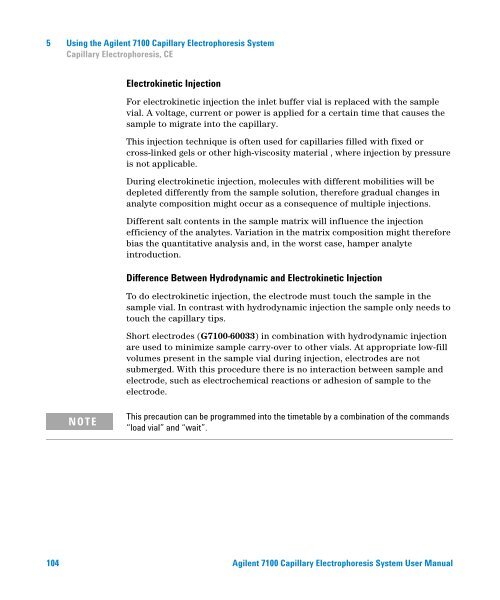Introduction to the Agilent 7100 Capillary Electrophoresis System
Introduction to the Agilent 7100 Capillary Electrophoresis System
Introduction to the Agilent 7100 Capillary Electrophoresis System
You also want an ePaper? Increase the reach of your titles
YUMPU automatically turns print PDFs into web optimized ePapers that Google loves.
5 Using <strong>the</strong> <strong>Agilent</strong> <strong>7100</strong> <strong>Capillary</strong> <strong>Electrophoresis</strong> <strong>System</strong><br />
<strong>Capillary</strong> <strong>Electrophoresis</strong>, CE<br />
Electrokinetic Injection<br />
For electrokinetic injection <strong>the</strong> inlet buffer vial is replaced with <strong>the</strong> sample<br />
vial. A voltage, current or power is applied for a certain time that causes <strong>the</strong><br />
sample <strong>to</strong> migrate in<strong>to</strong> <strong>the</strong> capillary.<br />
This injection technique is often used for capillaries filled with fixed or<br />
cross-linked gels or o<strong>the</strong>r high-viscosity material , where injection by pressure<br />
is not applicable.<br />
During electrokinetic injection, molecules with different mobilities will be<br />
depleted differently from <strong>the</strong> sample solution, <strong>the</strong>refore gradual changes in<br />
analyte composition might occur as a consequence of multiple injections.<br />
Different salt contents in <strong>the</strong> sample matrix will influence <strong>the</strong> injection<br />
efficiency of <strong>the</strong> analytes. Variation in <strong>the</strong> matrix composition might <strong>the</strong>refore<br />
bias <strong>the</strong> quantitative analysis and, in <strong>the</strong> worst case, hamper analyte<br />
introduction.<br />
Difference Between Hydrodynamic and Electrokinetic Injection<br />
To do electrokinetic injection, <strong>the</strong> electrode must <strong>to</strong>uch <strong>the</strong> sample in <strong>the</strong><br />
sample vial. In contrast with hydrodynamic injection <strong>the</strong> sample only needs <strong>to</strong><br />
<strong>to</strong>uch <strong>the</strong> capillary tips.<br />
Short electrodes (G<strong>7100</strong>-60033) in combination with hydrodynamic injection<br />
are used <strong>to</strong> minimize sample carry-over <strong>to</strong> o<strong>the</strong>r vials. At appropriate low-fill<br />
volumes present in <strong>the</strong> sample vial during injection, electrodes are not<br />
submerged. With this procedure <strong>the</strong>re is no interaction between sample and<br />
electrode, such as electrochemical reactions or adhesion of sample <strong>to</strong> <strong>the</strong><br />
electrode.<br />
NOTE<br />
This precaution can be programmed in<strong>to</strong> <strong>the</strong> timetable by a combination of <strong>the</strong> commands<br />
“load vial” and “wait”.<br />
104 <strong>Agilent</strong> <strong>7100</strong> <strong>Capillary</strong> <strong>Electrophoresis</strong> <strong>System</strong> User Manual
















